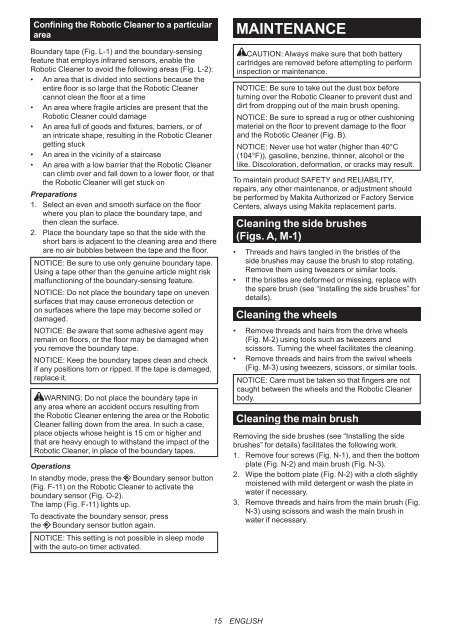Makita ROBOT PULITORE 18V - DRC200 - Manuale Istruzioni
Makita ROBOT PULITORE 18V - DRC200 - Manuale Istruzioni
Makita ROBOT PULITORE 18V - DRC200 - Manuale Istruzioni
Create successful ePaper yourself
Turn your PDF publications into a flip-book with our unique Google optimized e-Paper software.
Confining the Robotic Cleaner to a particular<br />
area<br />
Boundary tape (Fig. L-1) and the boundary-sensing<br />
feature that employs infrared sensors, enable the<br />
Robotic Cleaner to avoid the following areas (Fig. L-2):<br />
• An area that is divided into sections because the<br />
entire floor is so large that the Robotic Cleaner<br />
cannot clean the floor at a time<br />
• An area where fragile articles are present that the<br />
Robotic Cleaner could damage<br />
• An area full of goods and fixtures, barriers, or of<br />
an intricate shape, resulting in the Robotic Cleaner<br />
getting stuck<br />
• An area in the vicinity of a staircase<br />
• An area with a low barrier that the Robotic Cleaner<br />
can climb over and fall down to a lower floor, or that<br />
the Robotic Cleaner will get stuck on<br />
Preparations<br />
1. Select an even and smooth surface on the floor<br />
where you plan to place the boundary tape, and<br />
then clean the surface.<br />
2. Place the boundary tape so that the side with the<br />
short bars is adjacent to the cleaning area and there<br />
are no air bubbles between the tape and the floor.<br />
NOTICE: Be sure to use only genuine boundary tape.<br />
Using a tape other than the genuine article might risk<br />
malfunctioning of the boundary-sensing feature.<br />
NOTICE: Do not place the boundary tape on uneven<br />
surfaces that may cause erroneous detection or<br />
on surfaces where the tape may become soiled or<br />
damaged.<br />
NOTICE: Be aware that some adhesive agent may<br />
remain on floors, or the floor may be damaged when<br />
you remove the boundary tape.<br />
NOTICE: Keep the boundary tapes clean and check<br />
if any positions torn or ripped. If the tape is damaged,<br />
replace it.<br />
WARNING: Do not place the boundary tape in<br />
any area where an accident occurs resulting from<br />
the Robotic Cleaner entering the area or the Robotic<br />
Cleaner falling down from the area. In such a case,<br />
place objects whose height is 15 cm or higher and<br />
that are heavy enough to withstand the impact of the<br />
Robotic Cleaner, in place of the boundary tapes.<br />
Operations<br />
In standby mode, press the Boundary sensor button<br />
(Fig. F-11) on the Robotic Cleaner to activate the<br />
boundary sensor (Fig. O-2).<br />
The lamp (Fig. F-11) lights up.<br />
To deactivate the boundary sensor, press<br />
the Boundary sensor button again.<br />
NOTICE: This setting is not possible in sleep mode<br />
with the auto-on timer activated.<br />
MAINTENANCE<br />
CAUTION: Always make sure that both battery<br />
cartridges are removed before attempting to perform<br />
inspection or maintenance.<br />
NOTICE: Be sure to take out the dust box before<br />
turning over the Robotic Cleaner to prevent dust and<br />
dirt from dropping out of the main brush opening.<br />
NOTICE: Be sure to spread a rug or other cushioning<br />
material on the floor to prevent damage to the floor<br />
and the Robotic Cleaner (Fig. B).<br />
NOTICE: Never use hot water (higher than 40°C<br />
(104°F)), gasoline, benzine, thinner, alcohol or the<br />
like. Discoloration, deformation, or cracks may result.<br />
To maintain product SAFETY and RELIABILITY,<br />
repairs, any other maintenance, or adjustment should<br />
be performed by <strong>Makita</strong> Authorized or Factory Service<br />
Centers, always using <strong>Makita</strong> replacement parts.<br />
Cleaning the side brushes<br />
(Figs. A, M-1)<br />
• Threads and hairs tangled in the bristles of the<br />
side brushes may cause the brush to stop rotating.<br />
Remove them using tweezers or similar tools.<br />
• If the bristles are deformed or missing, replace with<br />
the spare brush (see “Installing the side brushes” for<br />
details).<br />
Cleaning the wheels<br />
• Remove threads and hairs from the drive wheels<br />
(Fig. M-2) using tools such as tweezers and<br />
scissors. Turning the wheel facilitates the cleaning.<br />
• Remove threads and hairs from the swivel wheels<br />
(Fig. M-3) using tweezers, scissors, or similar tools.<br />
NOTICE: Care must be taken so that fingers are not<br />
caught between the wheels and the Robotic Cleaner<br />
body.<br />
Cleaning the main brush<br />
Removing the side brushes (see “Installing the side<br />
brushes” for details) facilitates the following work.<br />
1. Remove four screws (Fig. N-1), and then the bottom<br />
plate (Fig. N-2) and main brush (Fig. N-3).<br />
2. Wipe the bottom plate (Fig. N-2) with a cloth slightly<br />
moistened with mild detergent or wash the plate in<br />
water if necessary.<br />
3. Remove threads and hairs from the main brush (Fig.<br />
N-3) using scissors and wash the main brush in<br />
water if necessary.<br />
15 ENGLISH
















